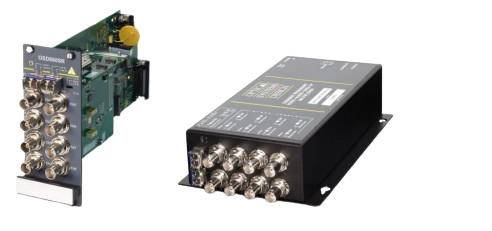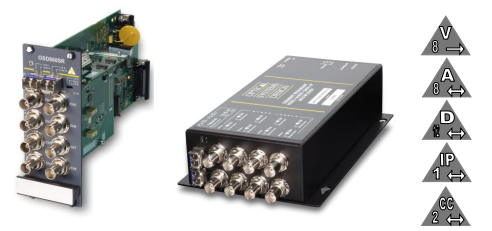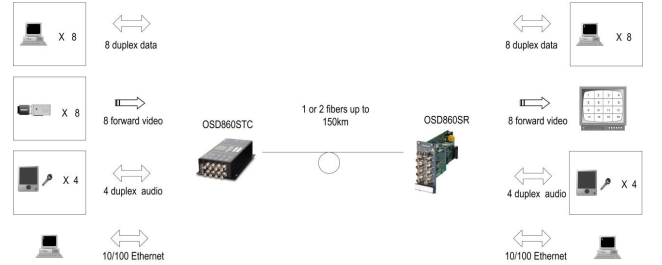Audio video data

OSD860S REDUNDANT LINK DIGITAL 4/8 CHANNEL VIDEO/AUDIO/DATA/ETHERNET MULTIPLEXER
PRODUCT DESCRIPTION
- Uncompressed 9 bit video, 24 bit audio encoding, giving professional quality transmission
- Fiber optic transmission of four or eight video signals on one fiber with four RS232 and RS422 data signals (two of each) which may be one way with the video. optionally, full duplex. Optional transmission of four audio and/or four additional high speed data channels which may be one way or full duplex. Alternatively, the user may
- transmit eight audio or eight extra data signals, again either one way or full duplex Range of up to 160km is possible with optional 1550nm operation and high sensitivity optical receiver
- Available with dual SFP transceivers for redundant optical link operation
- Optional duplex operation over one fiber Optional 10/100 Base-T Ethernet bridging through the link
- Optional duplex contact closure channels Operates over singlemode fiber. Very short distance operation over multimode fiber is possible: contact OSD for details
- Video bandwidth of 6 MHz, SNR >63dB Audio bandwidth of 15 kHz, SNR >100dB
- Video inputs have 3dB overload capability

OSD860S REDUNDANT LINK DIGITAL 4/8 CHANNEL VIDEO/AUDIO/DATA/ETHERNET MULTIPLEXER
FEATURES AND BENEFITS
- Uncompressed 9 bit video, 24 bit audio encoding, giving professional quality transmission
- Fiber optic transmission of four or eight video signals on one fiber with four RS232 and RS422 data signals (two of each) which may be one way with the video. optionally, full duplex. Optional transmission of four audio and/or four additional high speed data channels which may be one way or full duplex. Alternatively, the user may
- transmit eight audio or eight extra data signals, again either one way or full duplex Range of up to 160km is possible with optional 1550nm operation and high sensitivity optical receiver
- Available with dual SFP transceivers for redundant optical link operation
- Optional duplex operation over one fiber Optional 10/100 Base-T Ethernet bridging through the link
- Optional duplex contact closure channels Operates over singlemode fiber. Very short distance operation over multimode fiber is possible: contact OSD for details
- Video bandwidth of 6 MHz, SNR >63dB Audio bandwidth of 15 kHz, SNR >100dB
- Video inputs have 3dB overload capability
APPLICATIONS
- Ultra high reliability CCTV networks
- Video conferencing
- Transportation networks
- Industrial monitoring systems
TYPICAL APPLICATION DESIGN

specifications
CHANNEL AVAILABILITY
- (specify at time of order)
Forward Path
- Number of video channels 4 or 8
- Number of data channels 4
- Number of optional audio channels * 0, 4 or 8
- Number of optional high speed data channels * 0, 4 or 8
- Number of optional Ethernet interface 0 or 1
Reverse Path
- Number of video channels 0
- Number of data channels 0 or 4
- Number of optional audio channels * 0, 4 or 8
- Number of optional high speed data channels * 0, 4 or 8
- Number of optional Ethernet interface 0 or 1
SAMPLING RATE
Video
- Input/Output Impedance 75Ω
- Input/Output Level 1.0Vpp nominal
- Bandwidth (±0.5dB) 10Hz to 6MHz
- Signal to Noise Ratio >63dB (weighted)
- Linearity <0.7%, DG <0.7° DP
- Standard Data Interface 2 x RS232 and 2 x RS422
- Standard Data Rate DC to 150kbps
- Optional High Speed (HS) Data Interface RS232 or RS422 with RS485 also available on Channel 1
- Optional High Speed (HS) Data Rate DC to 400kbps
- Optional Ethernet Interface 10/100BaseT via RJ45 connector with system rate of 3.5Mbps
- Data Bit Error Rate <1×10-9
- Optional Contact Closure Interface One or two which replace one RS442 and one RS232 data channel
Audio
- Input/Output Impedance 10KΩ/200Ω balanced/unbalanced
- Input/Output Level 0dBu nominal, 15dBu maximum
- Bandwidth (±0.5dB) 10Hz to 15kHz
- Signal to Noise Ratio >100dB (A weighted at max level)
- Linearity <0.05% total harmonic distortion
- Video Connectors BNC
- Standard Data Connector Female 15 pin D connector
- Optional Audio/Data Connector Female 44 pin high density D connector
OPTICAL
- Transmitter wavelength 1310nm or 1550nm (including CWDM devices from 1470 to 1610nm)
- Transmitter coupled power Several options are available from –7dBm to +4dBm
- Receiver sensitivity <-22dBm (PIN) <-34dBm (APD)
- Reverse Path Sensitivity <-24dBm
- Link budget From 17dB to 36dB at 1310nm or 1550nm, depending on optical devices
- Optical Specifications and Connectors Refer to OSD860 SFP datasheet #102860SFP04
Notes: Many combinations of laser types and levels and receiver types and sensitivities are possible. Contact OSD for details. The OSD860S reverse path is not compatible with the OSD860 reverse path. The OSD860S is easily distinguishable because it employs one or two removeable SFP optical modules whereas the OSD860 has fixed optical connector(s) *It is possible to configure the unit as 8 audio+0 HS data, 4 audio+4 HS data or 0 audio+8 HS data.
PHYSICAL
- Power Requirements 10 to 30VDC @ 12VA (modem case)
- 90 to 265 VAC @ 20VA, -48VDC power is optional (2RU enclosure)
- Dimensions (mm)
- [ 100W x 208D x 50H card ]
- [ 105W x 210D x 55H modem case ]
- [ 483W x 210D x 88H 2RU enclosure ]
- Weight 0.2kg (card), 1.0kg (modem case), 3.1kg (2RU enclosure)
- Operating Temperature -20 to +75°C
- Relative Humidity 0 to 95% non-condensing
- Chassis Current Consumption [ 0.50 Amp for 4-channel video version ]
- [ 0.70 Amp for 8-channel video version ]
- [ Add 0.30 Amp for additional audio, data and/or Ethernet channels ]
Request a Quote
Learn More From
Frequently Asked Questions
Multimode fiber commonly comes in 50/125 μm or 62.5/125 μm core/cladding dimensions, with bandwidth capacities ranging from 200 MHz to 2 GHz, depending on the grade. Multimode systems typically support transmission distances of up to 5 km, making them suitable for short- to medium-range applications.
In contrast, singlemode fiber—usually 9–10/125 μm—offers significantly lower attenuation and effectively unlimited bandwidth, supporting links over 150 to 200 km, especially when paired with optical amplifiers and advanced transceivers.
While singlemode fiber is less expensive per meter, its associated transceivers and equipment tend to cost more than their multimode counterparts. That said, singlemode devices are generally compatible with both singlemode and multimode fiber, whereas multimode equipment works only with multimode fiber.
Let me know if you’d like this turned into a quick-reference table or visual comparison—it’d make a solid inclusion for a fiber deployment guide.
The link budget is the difference between the transmitter’s output power and the receiver’s sensitivity. This budget must account for all signal losses along the path, including:
- Fiber attenuation due to the transmission medium
- Connector losses, such as those at patch panels or equipment interfaces
- Splice losses from mechanical or fusion joints
- Link margin, which provides a buffer for unforeseen variations
The link margin typically ranges from 2–3 dB in tightly controlled environments to up to 10 dB in more variable conditions. It is designed to accommodate:
- Component aging (e.g., light sources may degrade and lose up to 3 dB over time)
- Temperature variations affecting transmitter output or receiver sensitivity (up to 3 dB may be needed for thermal fluctuations)
- Physical cable damage and repair-induced losses (usually minor, but more relevant in harsh or industrial settings)
Always design your system for worst-case scenarios to ensure reliability. However, don’t overlook the best-case condition either—some optical receivers may exhibit erratic behavior if the incoming signal is too strong.
First, verify the optical signal strength along the link. Use an optical power meter to measure the received power at the fiber’s end point. Typical transmit levels range from –8 dBm to –15 dBm, while the receiver sensitivity is around –31 dBm, giving you a link budget of approximately 16 dB. This margin supports transmission distances of up to 10 km on singlemode fiber and about 3–5 km on multimode fiber.
If the measured power falls below the receiver sensitivity, there’s a strong likelihood of issues with the installed fiber. Ideally, initial OTDR readings should have flagged such faults.
If not, inspect the patch cords currently in use for possible defects or misalignment. A frequent oversight is the use of mismatched patch cords.
Multimode fiber types are classified by the ISO/IEC 11801 standard into five main categories: OM1, OM2, OM3, OM4, and OM5. Each type differs in core size, bandwidth, supported data rates, and maximum transmission distances. Here’s a quick breakdown:

- OM3 and OM4 are laser-optimized and widely used in modern data centers.
- OM5 supports shortwave wavelength division multiplexing (SWDM), enabling multiple wavelengths over a single fiber for higher capacity.
- All OM types are backward compatible in terms of connectors, but mixing core sizes (e.g., OM1 with OM3) can cause performance issues.
